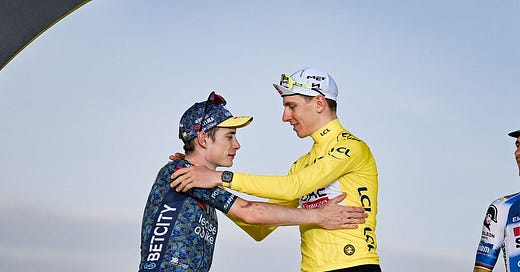The ultimate Tour de France preview
The battle between Pogačar and Vingegaard is one for the history books. A look at the teams, favourites, route and potential surprises.
Starting today, Cycling Report is a subscription-only publication. If you enjoy what you read, give it a try!
What you’ll find:
✅ General race preview
✅ The favourites head-to-head
✅ All teams and their ambitions
✅ Stage profiles in detail
✅ Official Roadbook
✅ Podium contenders
✅ Jersey favourites – yellow, green, polka dot, white
When the Tour de France was first held in 1903, its purpose was never just sport. L’Auto — the newspaper behind the race and predecessor to L’Équipe — created it with a clear mission: to stir emotions, to tell unforgettable stories, and yes, to sell papers. One goal, two means.
More than a century later, the formats have evolved and the business of entertainment has evolved into something entirely new. And yet, the Tour endures — not just as a bike race, but as an event where legends are written. UCI points, sportwashing, TV rights, performance data… these are the vocabulary of modern cycling. But the essence remains unchanged. History is waiting to be written. Again.
Never before have two riders dominated the GC in such a consistent way. Tadej Pogačar and Jonas Vingegaard have shared the top two steps of the podium for four consecutive editions. And everything suggests 2025 will mark the fifth.
Tadej Pogačar and Jonas Vingegaard are shaping one of the most electrifying rivalries in the history of sport. The contrast in their personalities, character and the way they approach and interpret both the Tour and the sport itself only serves to heighten the rivalry. What we are witnessing today will stand the test of time.
They are not racing alone, of course, but the two main favourites face a route designed to showcase their full range of strengths — and reveal a few of their weaknesses.
How do you beat Pogačar?
The million-dollar question. ASO has designed a route that may stir up some ghosts in the Slovenian’s mind. Just as they did at the Critérium du Dauphiné with the climb to Domancy and the finish in Combloux — the site of one of the most memorable ITT in recent years, where Vingegaard beat Pogačar — the 2025 Tour de France includes Mont Ventoux, where Vingegaard first dropped Pogačar back in 2021, Hautacam, where Van Aert and Vingegaard sealed the race on the iconic 2022 ascent, and the Col de la Loze. “I’m gone, I’m dead.”
Even so, this is far from being an anti-Pogačar Tour. The Slovenian has spent the past 18 months performing at a level rarely seen before and faces an opening week full of short climbs and punchy finishes before reaching his natural habitat: the Pyrenees.
Still, Vingegaard has reasons for hope. In 2024, despite limited preparation following his crash at Itzulia, he managed to stay relatively close in the mountain stages. The Dauphiné was a different story — it was his first race in three months after the crash at Paris–Nice — but signs of improvement were there.
There are four areas where Visma may look for signs of ‘weakness’ in Pogačar:
Heat: As seen in the Dauphiné time trial and on multiple occasions throughout his career, Pogačar struggles in extreme heat. Forecasts remain uncertain, and in the Pyrenean valleys around Bagnères-de-Bigorre, hot days above 30°C are still alternating with rain predictions. Like almost every aspect of his riding, he’s improved… but this remains one area where Vingegaard appears more consistent.
Altitude: It is another area in which Pogačar has shown notable improvement since that explosion on the Col de la Loze or the unforgettable day on the Galibier–Granon. His 2024 campaign offered proof that he has progressed on terrain where Vingegaard’s weight and pure climber qualities should, in theory, level the playing field.
Time Trial: Not everything is determined by the past, but UAE’s time trial form in 2025 has clearly dipped compared to last season. Nearly all of their riders have regressed in this discipline. Pogačar’s individual performance at the Critérium du Dauphiné was poor, and the numbers are telling: the team closed 2024 with 17 time trial wins, while in 2025 they have managed just three – and until João Almeida’s victory in Switzerland a couple of weeks ago, they had none.
Vingegaard and Visma have looked sharp in the discipline since early in the season – already at the Volta ao Algarve – and head into both the flat 33km test in Caen (stage 5) and the 11km uphill time trial to Peyragudes (stage 13) with a slight edge over UAE, at least on paper.The Opening Block: This year’s Tour de France presents an atypical layout in two ways: it does not cross the French border at any point – something that has happened only rarely in the 21st century – and it features a 10-stage opening block designed so that the 10th stage, held on 14 July – Bastille Day – does not fall on a rest day, as that Monday will be a racing day.



